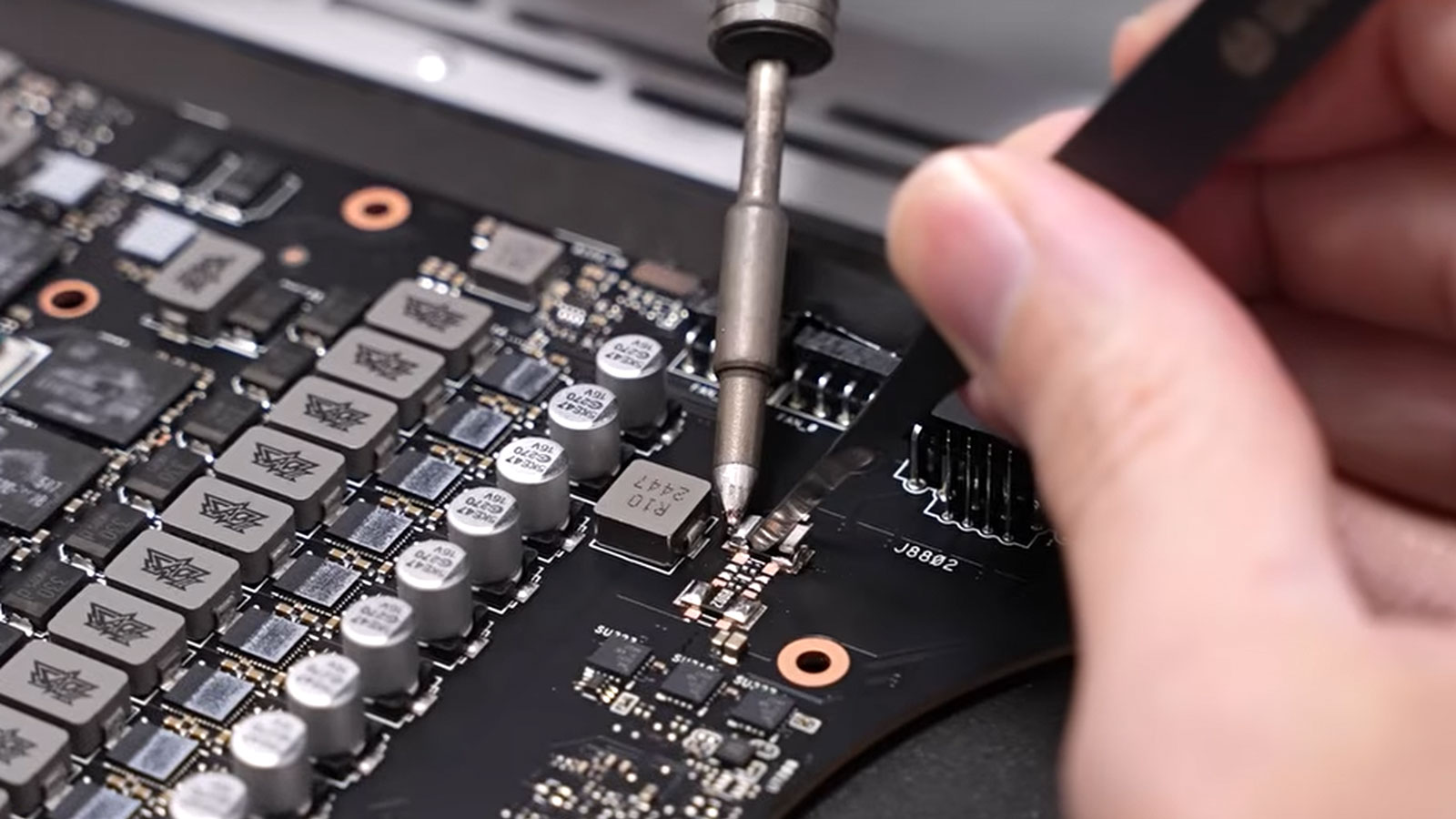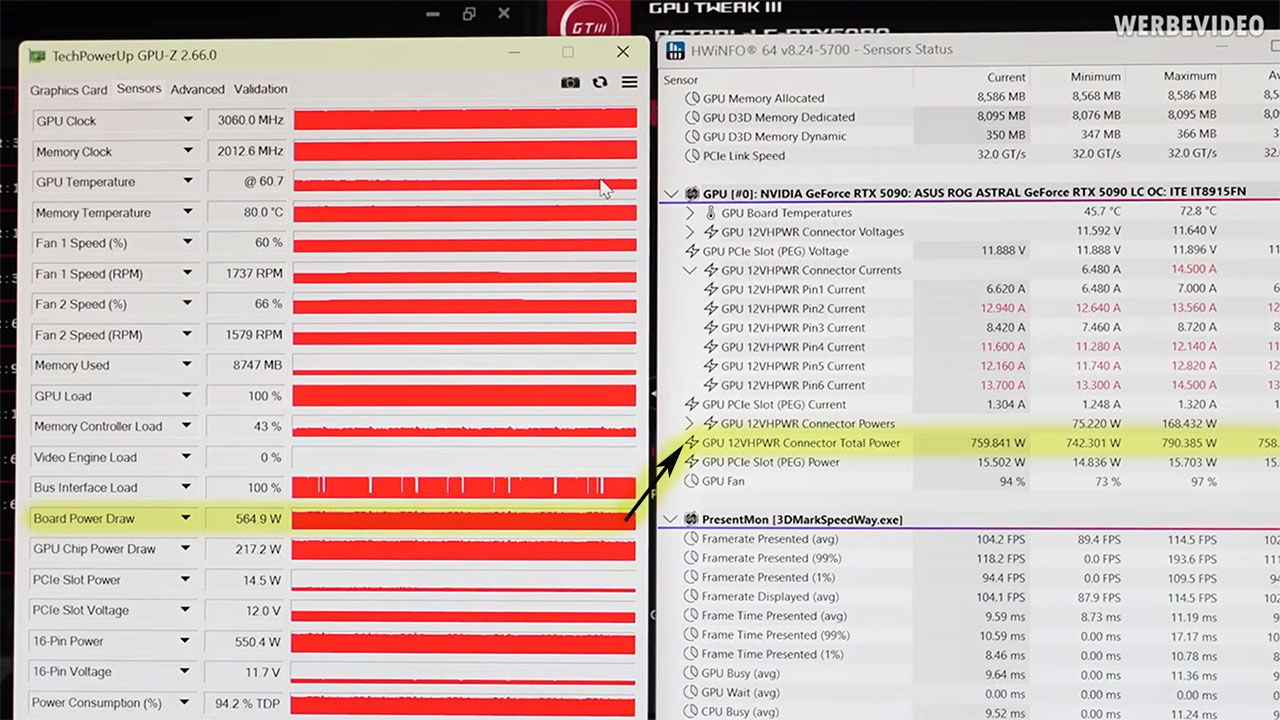Nvidia RTX 5090 beats RTX Pro 6000 in tests after shunt mod to a staggering 800W — consumer flagship barely scrapes past the $10,000 Pro despite eye-watering power modification
The performance increase looks poor compared to the increased power consumption, though.

An Asus ROG Astral LC RTX 5090 has been shunt modded, resulting in its performance eclipsing the $10,000 RTX Pro 6000. This kind of PCB surgery mod is notorious for resulting in damaged graphics cards, so please monkey-see monkey-do with extreme caution. However, the video of this particular feat was put together by overclocking legend Der8auer, so everything went extremely smoothly and to plan. Below, we will ponder over the process, the results, and consider whether the work and risks are worth it.
Shunt mod – a procedure to increase the hardware power limit
As briefly mentioned above, shunt modding can be dangerous to the life of your GPU. If mistakes are made, your $$$ GPU could degrade slowly, or become toast extremely quickly. As well as any concerns about the actual mod to the PCB, remember that any strain on the 16-pin power connector could become even more perilously high at 800W.
A great shunt mod candidate
Der8auer told viewers that he waited until he could get a capable AiO card for this shunt mod experiment, as it should be better at handling the greater power. And indeed, the Asus ROG Astral LC RTX 5090 runs quieter than the ‘vanilla’ Astral, according to the overclocker. All else being equal, the Astral cards offer a welcome degree of parameter adjustment and monitoring options via Asus GPU Tweak III – this will be useful later.
First things first, Der8auer set a baseline for out-of-the-box Astral LC RTX 5090 performance. During this initial assessment, he observed that it was hitting the standard 600W power target constantly when under load, but seemed “pretty quiet” and capable of handling more juice. It was concluded by the OC expert that the 600W limit was definitely reducing OC potential.
Now the decision had been made and baselines recorded – it was time to crack open the LC and mod the PCB. We won’t get into the details of how to shunt mod, but you can see an overview of the procedure in the video embedded above. But in brief, the mod is rather straightforward. It simply requires changes to be made to the resistors coming from the power connector to ‘fool’ the controlling circuitry into thinking less power is coming in to the PCB than there actually is... With the resistor replacements Der8auer chose, the mod would allow “us in theory to get about 30% higher power draw without the card noticing.” Thus, a separate piece of hardware, called WireView, would be used to see the actual power draw. In the case of the Astral cards, you also have pin sensing on the 16-pin power input, so that is another view of the incoming power that is available, and should remain useful.



Results and conclusion
The mod went well, and WireView reported about 660 to 700W being used under modest benchmark loads. That contrasts with the GPU-Z readout of around 500W. It was also observed that there was 15 to 20% more headroom left until the new power limit would be hit.
During fresh benchmarks, the CPU only occasionally ran into the new power limit; most of the time, it seems to be at around 750W during the tests. Then it was decided to delve into manual overclocking, with acceptable temperatures and noise levels continuing.
Get Tom's Hardware's best news and in-depth reviews, straight to your inbox.
To conclude, the shunt-modded RTX 5090 beats the $10,000 RTX Pro 6000, but only just. You can also see an alarmingly higher power consumption vs both the unmodded RTX 5090 and the professional graphics card with its 96GB VRAM. Der8auer was pleased and called the result “quite nice.” However, we think it is worth underlining our earlier comments about the dangers of doing a shunt mod on expensive graphics cards.
Follow Tom's Hardware on Google News to get our up-to-date news, analysis, and reviews in your feeds. Make sure to click the Follow button.

Mark Tyson is a news editor at Tom's Hardware. He enjoys covering the full breadth of PC tech; from business and semiconductor design to products approaching the edge of reason.
-
edzieba Reply
Perfectly fine, as long as it remained properly seated. Micro-fit+ connectors support 10.5A per pin continuous load at 125°C (126W per pin at 12v, or a hair under 800W per 12-pin connector), so with the 75W from the card-edge power rail 800W remains - barely - within spec. With some active cooling (i.e. point a fan at it) higher powers should be reasonable for short periods such as benchmarking runs, since the -Fit connector line tend to be overspecced.TheyStoppedit said:I'd like to see what the connector looked like after that was all done.... Lol
The issue comes when the connector is not fully seated and some of the pins do not make proper contact, and thus increase resistance (which leads to heating, which leads to more resistance, and in the worst case thermal runaway). Regular Mini-Fit Jr. (AKA 'PCIe power') connectors can suffer from the same, but since they generally have fewer pins they are more difficult to misalign, though a quick google for "melted PCIe 6-pin" or "melted PCIe 8-pin" will turn up plenty of examples. -
borthe I did a shunt mod on a 2080ti a few years ago that worked out great. It was the first time I ever tried soldering a pcb too. The card was watercooled and I used it for about a year after without any problems until I sold it. Probably won't be trying that again though.Reply -
thestryker Reply
If you watched the video you'd know the power wasn't balanced and two pins were carrying notably less than the rest. While I'm sure the connector was fine likely wouldn't be long term. At least with the Astral card there's per pin measurements so that can be monitored and dealt with.edzieba said:Perfectly fine, as long as it remained properly seated. Micro-fit+ connectors support 10.5A per pin continuous load at 125°C (126W per pin at 12v, or a hair under 800W per 12-pin connector), so with the 75W from the card-edge power rail 800W remains - barely - within spec. With some active cooling (i.e. point a fan at it) higher powers should be reasonable for short periods such as benchmarking runs, since the -Fit connector line tend to be overspecced. -
alceryes Reply
This statement has been demonstrated to be false.edzieba said:...The issue comes when the connector is not fully seated...
Even with a fully seated 12V-2x6 connector, there can be large differences in individual pin contact area, resistences, and heat production.
If the 12VHPWR (and 12V-2x6) standard had the same safety margins that the OG 8-pin connectors had, we wouldn't be having this conversation and those hundreds (thousands?) of people who have lost GPUs due to a faulty design, would still have happy, working GPUs. -
_D_D Reply
Specs I've seen are 9.2A max for a maximum 30C rise in temperature. Connector last I looked was rated for 105C but maybe that has changed? Also 12V IIRC allows for -8% tolerance so very slightly over 600W on a unlikely perfectly balanced supply.edzieba said:Perfectly fine, as long as it remained properly seated. Micro-fit+ connectors support 10.5A per pin continuous load at 125°C (126W per pin at 12v, or a hair under 800W per 12-pin connector), so with the 75W from the card-edge power rail 800W remains - barely - within spec.
